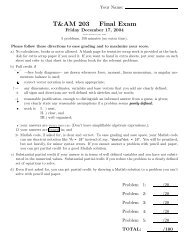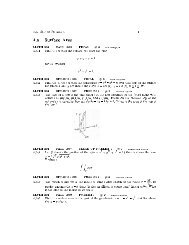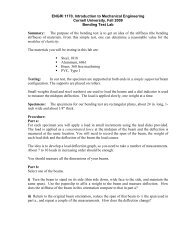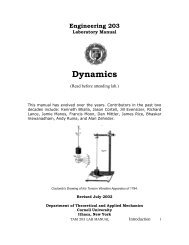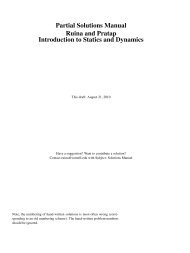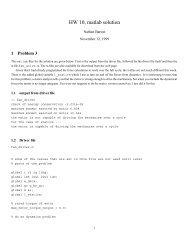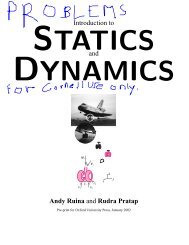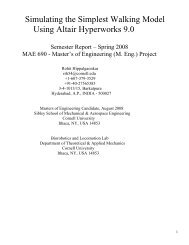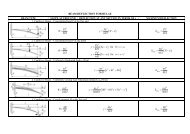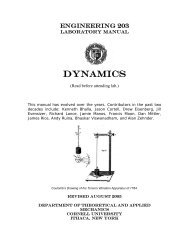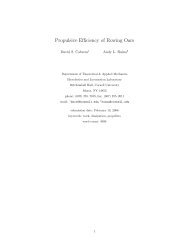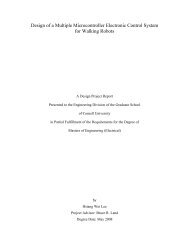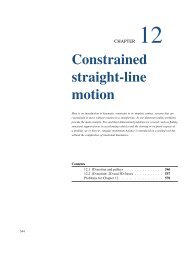Introduction to and Andy Ruina and Rudra Pratap
Introduction to and Andy Ruina and Rudra Pratap
Introduction to and Andy Ruina and Rudra Pratap
You also want an ePaper? Increase the reach of your titles
YUMPU automatically turns print PDFs into web optimized ePapers that Google loves.
6 Chapter 0. Detailed Contents Detailed Contents<br />
Box 9.4 Particle models for the energetics of locomotion . . 429<br />
9.3 Vibrations: mass, spring <strong>and</strong> dashpot . . . . . . . . . . . . . 436<br />
Box 9.5 A cos.t/ C B sin.t/ D R cos.t / . . . . . 441<br />
Box 9.6 Solution of the damped-oscilla<strong>to</strong>r equations . . . . 447<br />
9.4 Coupled motions in 1D . . . . . . . . . . . . . . . . . . . . 461<br />
Box 9.7 Normal modes: the math <strong>and</strong> the recipe . . . . . . 468<br />
9.5 Collisions in 1D . . . . . . . . . . . . . . . . . . . . . . . . 476<br />
Box 9.8 When equal rods collide the vibrations disappear . 481<br />
9.6 Advanced: forcing & resonance . . . . . . . . . . . . . . . . 485<br />
Box 9.9 A Loudspeaker cone is a forced oscilla<strong>to</strong>r. . . . . . 490<br />
Box 9.10 Solution of the forced oscilla<strong>to</strong>r equation . . . . . 492<br />
Box 9.11 The vocabulary of forced oscillations . . . . . . . 493<br />
Problems for Chapter 9 . . . . . . . . . . . . . . . . . . . . . . . 501<br />
10 Particles in space 514<br />
This chapter is about the vec<strong>to</strong>r equation F<br />
* D m * a for one particle.<br />
Concepts <strong>and</strong> applications include ballistics <strong>and</strong> planetary motion. The<br />
differential equations of motion are set-up in cartesian coordinates <strong>and</strong><br />
integrated either numerically, or for special simple cases, by h<strong>and</strong>. Constraints,<br />
forces from ropes, rods, chains floors, rails <strong>and</strong> guides that can<br />
only be found once one knows the acceleration, are not considered.<br />
Box 10.1 New<strong>to</strong>n’s laws in New<strong>to</strong>nian reference frames . . 516<br />
10.1 Dynamics of a particle in space . . . . . . . . . . . . . . . . 517<br />
Box 10.2 The derivative of a vec<strong>to</strong>r depends on frame . . . 524<br />
10.2 Momentum <strong>and</strong> energy . . . . . . . . . . . . . . . . . . . . 533<br />
Box 10.3 Conservative forces <strong>and</strong> non-conservative forces 539<br />
Box 10.4 Particle theorems for momenta <strong>and</strong> energy . . . . 541<br />
10.3 Central-force motion <strong>and</strong> celestial mechanics . . . . . . . . . 545<br />
Problems for Chapter 10 . . . . . . . . . . . . . . . . . . . . . . . 555<br />
11 Many particles in space 562<br />
This more advanced chapter concerns the motion of two or more particles<br />
in space. We will use * F D m * a for each particle. We will use Cartesian<br />
coordinates only. The start is the set up of “two-body” type problems<br />
which are easily generalized <strong>to</strong> 3 or more particles. The first section concerns<br />
smooth motions due <strong>to</strong> forces from gravity, springs, smoothly applied<br />
forces <strong>and</strong> friction. The second section concerns the sudden change<br />
in velocities when impulsive forces are applied.<br />
11.1 Coupled particle motion . . . . . . . . . . . . . . . . . . . . 564<br />
11.2 particle collisions . . . . . . . . . . . . . . . . . . . . . . . 572<br />
Box 11.1 Effective mass . . . . . . . . . . . . . . . . . . . 574<br />
Box 11.2 Energetics of collisions . . . . . . . . . . . . . . 575<br />
Box 11.3 Coefficient of generation . . . . . . . . . . . . . 578<br />
Box 11.4 A particle collision model of running . . . . . . . 579<br />
Problems for Chapter 11 . . . . . . . . . . . . . . . . . . . . . . . 584<br />
12 Straight line motion 588



